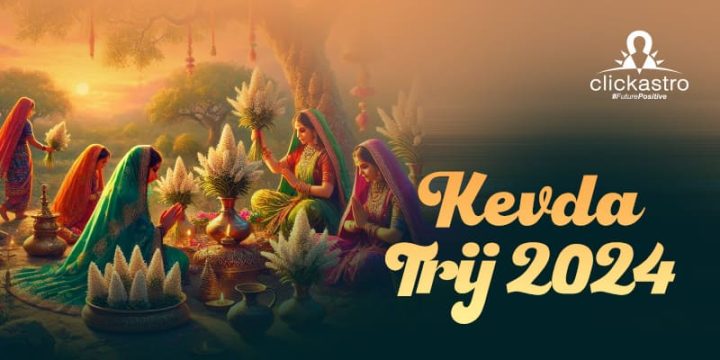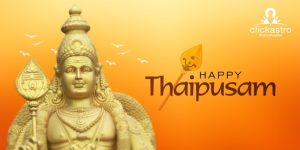Introduction
Kevda Trij, also known as Kevda Teej, is a Hindu festival that is deeply revered and widely celebrated, especially by women in various Indian states such as Gujarat, Rajasthan, Bihar, Jharkhand, Uttar Pradesh, Madhya Pradesh, Chhattisgarh, and Maharashtra. The festival occurs on the third day of the
Shukla Paksha (waxing phase of the moon) in the month of Bhadarvo, which,
in 2024, falls on Friday, September 6.
Dedicated to Goddess Parvati, Kevda Trij is a day when women perform rituals and customs with deep devotion, seeking blessings for a prosperous and fulfilling life. The festival is marked by fasting, prayer, and offerings, symbolizing the hope for marital happiness, well-being, and the fulfilment of personal desires. The celebration underscores the cultural and spiritual significance of devotion to Goddess Parvati, reflecting the rich traditions and beliefs passed down through generations.
The Significance of Kevda Trij
The significance of Kevda Trij lies in its connection with the devotion and blessings of Goddess Parvati and Lord Shiva. This festival is closely associated with the
Hartalika Teej Vrat, another important Hindu festival focused on women engaging in fasting and prayer to honour these deities. The practices observed during Kevda Trij come with rich cultural traditions and are specifically aimed at invoking the blessings of Parvati, who is seen as a symbol of marital bliss, strength, and perseverance.

For married women, Kevda Trij is an opportunity to ensure the happiness and prosperity of their married lives. The rituals they perform seek the well-being of their husbands and the stability of their households. On the other hand, unmarried women observe the Vrat with the hope of finding an ideal life partner. The fast and rituals are expressions of their faith, which they believe will bring them the partner of their dreams.
Central to the festival is the offering of the Kevda flower, also known as the fragrant screw pine. This flower holds a unique place in Hindu culture and the festival itself. According to legends, the Kevda flower was cursed by Lord Shiva, making its use in religious rituals extremely rare. Despite this, the flower is an essential offering during Kevda Trij, symbolizing the profound and rare connection between the devotees and the deities they honour. Its use during this festival is seen as a powerful gesture, one that transcends the curse and signifies the purity and sincerity of the devotees’ intentions.
Beyond its religious significance, the Kevda flower is valued for its fragrance and its use in the production of aromatic oils and perfumes. It is also known for its medicinal properties and is used in traditional remedies for headaches, rheumatism, and skin ailments. This multifaceted importance makes the Kevda flower a potent symbol during the Kevda Trij festival, blending spirituality with practical benefits. Through these offerings and observances, Kevda Trij serves as a celebration of devotion, resilience, and the timeless bond between the divine and the human spirit.
Rituals and Celebrations of Kevda Trij
Rituals and celebrations of Kevda Trij are rooted in devotion, purity, and cultural traditions. The day begins with women rising early to take a holy bath, a cleansing ritual that symbolizes the purification of body and soul. This act of purification sets the tone for the day’s spiritual activities. After the bath, women dress in new clothes, typically in shades of red or green. Red is considered an auspicious colour that represents prosperity, love, and marital happiness, while green symbolizes renewal, growth, and good fortune. These vibrant colours, combined with traditional ornaments, enhance the beauty and grace of the women as they prepare for worship.
Once adorned in their festive attire, the women proceed to the temple to offer prayers to Goddess Parvati. The temple becomes a focal point of communal worship, where the atmosphere is filled with devotion and reverence. Women bring with them a variety of offerings, including fresh fruits, flowers, and green vegetables, which they present to the goddess. These offerings are symbols of fertility, abundance, and the sustenance that Goddess Parvati provides.
Among these offerings, the Kevda flower holds special significance. Despite its mythological curse, the Kevda flower is offered to both Goddess Parvati and Lord Shiva during the rituals, symbolizing the deep connection and harmony between the divine couple. The offering of this fragrant flower represents the devotion and sincerity of the worshippers, and it is believed to invoke the blessings of the deities.
Following the temple rituals, many women return home to continue the celebrations. Special dishes are prepared to mark the occasion, with coconut-based dishes being a particular speciality. The use of coconut in these dishes reflects the cultural richness and diversity of the regions where Kevda Trij is celebrated, as well as the importance of food in religious observances. These culinary traditions bring families together, fostering a sense of community and shared devotion. Through these rituals and celebrations, Kevda Trij becomes a vibrant expression of faith, culture, and the enduring bond between the devotees and the divine.
The Kevda Trij Vrat: A Test of Devotion
The Kevda Trij Vrat is an expression of devotion and spiritual commitment, forming the heart of this sacred festival. The practice of fasting, or Vrat, symbolizes the depth of the devotees’ faith and their desire to seek the blessings of Goddess Parvati. According to legend, Goddess Parvati herself undertook severe penance, or tapasya, to win the love and attention of Lord Shiva. Her unwavering devotion and determination eventually led to their divine union. Inspired by this legendary tale, women observe the Kevda Trij Vrat as a means of emulating Parvati’s dedication, hoping to receive her blessings for a fulfilling and prosperous life.
The Vrat observed on Kevda Trij is particularly rigorous, often taking the form of a
nirjala vrat, where participants refrain from consuming even a drop of water throughout the day. This type of fasting is considered one of the most challenging forms of penance, requiring immense personal strength, discipline, and spiritual focus. By enduring these hardships, devotees demonstrate their unwavering faith and their willingness to sacrifice for the blessings they seek.
For married women, the Vrat is performed to ensure the health, happiness, and longevity of their husbands, as well as the overall prosperity of their families. Unmarried women, on the other hand, observe the fast in the hope of finding a suitable life partner who embodies the qualities of Lord Shiva. The act of fasting is more than a mere ritual; it is a spiritual exercise that tests the devotee’s resolve and deepens their connection to the divine.
It is believed that those who observe the Kevda Trij Vrat with sincerity and devotion are blessed with the love and favour of Goddess Parvati. This divine favour is thought to bring happiness, prosperity, and marital bliss into their lives, making the Vrat a cherished tradition passed down through generations. The Vrat not only honours the goddess but also strengthens the spiritual resolve of those who undertake it, reaffirming their commitment to a life of faith and devotion.
Get Your Free Marriage Predictions
The Background of Kevda Trij
The background of Kevda Trij is intertwined with the revered story of Goddess Parvati’s unwavering devotion to Lord Shiva, one of the most enduring love stories in Hindu culture. The festival finds its roots in the ancient narrative of Parvati’s relentless efforts to win the heart of Shiva, following the tragic death of his first consort, Sati.
According to the scriptures, Sati’s demise left Shiva devastated, plunging him into profound grief and detachment from the world. Overcome with sorrow, Shiva withdrew into deep meditation in the Himalayas, renouncing all worldly connections. During this period of asceticism, Shiva became indifferent to love and marriage, leaving Parvati, the reincarnation of Sati, with the daunting task of rekindling his affection.
Determined to break through Shiva’s emotional isolation, Parvati undertook an intense penance, or tapasya, in the rugged terrain of the Himalayas. She subjected herself to the most severe austerities, enduring extreme weather conditions, subsisting on leaves, fruits, and sometimes nothing at all. Her penance was marked by profound discipline, demonstrating her unwavering commitment and love for Shiva. Parvati’s tapasya is often described as lasting for several years, a period during which she demonstrated incredible spiritual strength and perseverance.
The intensity of Parvati’s devotion eventually softened Shiva’s heart. Moved by her determination, purity, and the depth of her love, Shiva was compelled to acknowledge her devotion. He emerged from his meditation and accepted Parvati as his eternal consort, agreeing to marry her. Their union is celebrated in Hinduism as a divine symbol of love, commitment, and the balance of feminine and masculine energies in the universe.
Kevda Trij commemorates this sacred narrative by encouraging women to emulate Parvati’s devotion in their own lives. The festival’s rituals, particularly the fasting and prayers, reflect this mythological background, as women seek to invoke Parvati’s blessings for marital harmony, prosperity, and personal strength. The story of Parvati and Shiva remains a powerful reminder of the transformative power of love and devotion, making Kevda Trij a spiritually significant observance for those who partake in it.
Conclusion
Kevda Trij is more than just a festival; it is a profound celebration of devotion, love, and the timeless bond between Shiva and Parvati. This observance highlights the enduring faith and cultural richness of Hindu tradition, where rituals and customs are deeply intertwined with daily life and practised with sincerity and reverence. As women across various regions prepare to observe Kevda Trij on September 6, 2024, they will honour this sacred day with the same devotion that has preserved the tradition for centuries. Through fasting, prayers, and communal gatherings, these women seek the blessings of Goddess Parvati and Lord Shiva, ensuring that their lives are imbued with happiness, prosperity, and divine grace. The festival serves as a reminder of the power of love, dedication, and spiritual connection, resonating with the values that have shaped Hindu culture and spirituality across generations.
 For married women, Kevda Trij is an opportunity to ensure the happiness and prosperity of their married lives. The rituals they perform seek the well-being of their husbands and the stability of their households. On the other hand, unmarried women observe the Vrat with the hope of finding an ideal life partner. The fast and rituals are expressions of their faith, which they believe will bring them the partner of their dreams.
Central to the festival is the offering of the Kevda flower, also known as the fragrant screw pine. This flower holds a unique place in Hindu culture and the festival itself. According to legends, the Kevda flower was cursed by Lord Shiva, making its use in religious rituals extremely rare. Despite this, the flower is an essential offering during Kevda Trij, symbolizing the profound and rare connection between the devotees and the deities they honour. Its use during this festival is seen as a powerful gesture, one that transcends the curse and signifies the purity and sincerity of the devotees’ intentions.
Beyond its religious significance, the Kevda flower is valued for its fragrance and its use in the production of aromatic oils and perfumes. It is also known for its medicinal properties and is used in traditional remedies for headaches, rheumatism, and skin ailments. This multifaceted importance makes the Kevda flower a potent symbol during the Kevda Trij festival, blending spirituality with practical benefits. Through these offerings and observances, Kevda Trij serves as a celebration of devotion, resilience, and the timeless bond between the divine and the human spirit.
For married women, Kevda Trij is an opportunity to ensure the happiness and prosperity of their married lives. The rituals they perform seek the well-being of their husbands and the stability of their households. On the other hand, unmarried women observe the Vrat with the hope of finding an ideal life partner. The fast and rituals are expressions of their faith, which they believe will bring them the partner of their dreams.
Central to the festival is the offering of the Kevda flower, also known as the fragrant screw pine. This flower holds a unique place in Hindu culture and the festival itself. According to legends, the Kevda flower was cursed by Lord Shiva, making its use in religious rituals extremely rare. Despite this, the flower is an essential offering during Kevda Trij, symbolizing the profound and rare connection between the devotees and the deities they honour. Its use during this festival is seen as a powerful gesture, one that transcends the curse and signifies the purity and sincerity of the devotees’ intentions.
Beyond its religious significance, the Kevda flower is valued for its fragrance and its use in the production of aromatic oils and perfumes. It is also known for its medicinal properties and is used in traditional remedies for headaches, rheumatism, and skin ailments. This multifaceted importance makes the Kevda flower a potent symbol during the Kevda Trij festival, blending spirituality with practical benefits. Through these offerings and observances, Kevda Trij serves as a celebration of devotion, resilience, and the timeless bond between the divine and the human spirit.







